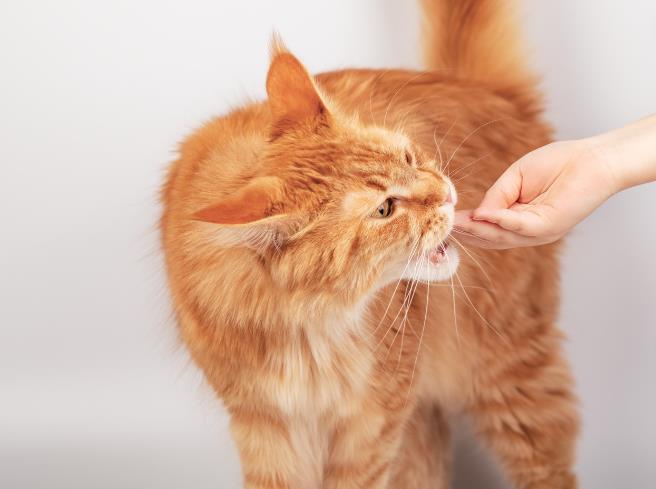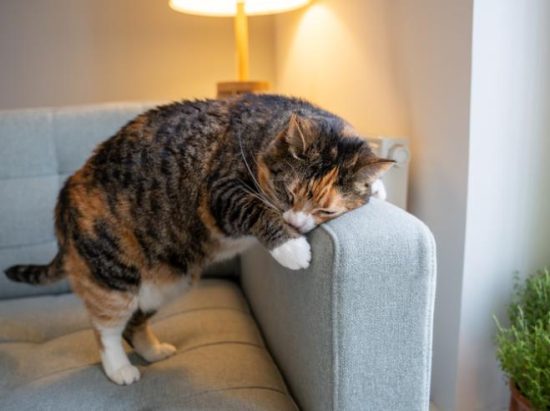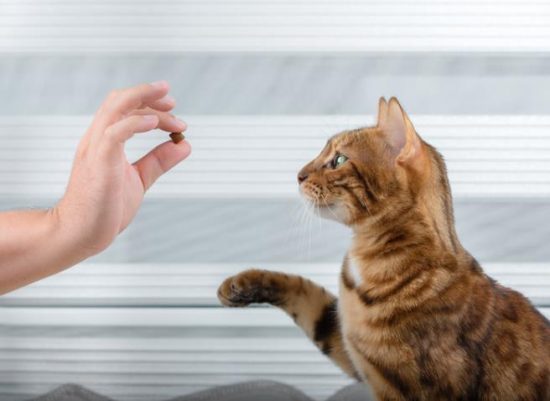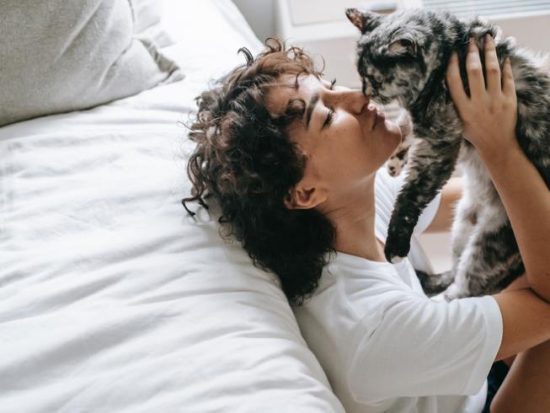How to Discipline a Cat: Effective Training Methods
How to Discipline a Cat: Effective Training Methods – Learn practical strategies for curbing unwanted feline behaviors through positive reinforcement and redirection techniques.

Did you know that the average cat owner spends over $1,000 annually on repairing damage caused by their feline companions? From scratched furniture to ruined curtains, the cost of undisciplined cat behavior can quickly add up. But the good news is, with the right training methods, you can effectively curb your cat’s misbehavior and maintain a harmonious household.
In this comprehensive guide, we’ll explore proven techniques on how to discipline a cat and teaching them to obey your commands. Whether you’re struggling to stop your cat from misbehaving, wondering what the best discipline approach is, or simply aiming to train your cat to be more obedient, we’ve got you covered. Get ready to learn the secrets of effective cat training and take back control of your home.
Understanding Cat Behavior

To effectively discipline your feline friend, it’s crucial to have a deeper understanding of cat behavior. Cats can exhibit a wide range of behaviors, and recognizing the underlying reasons behind these actions is the key to addressing them effectively.
Anticipating Your Cat’s Needs
Cats are often misunderstood, as their behaviors may not always align with human expectations. However, by anticipating your cat’s needs, you can better understand why they may be misbehaving. Factors such as hunger, boredom, anxiety, and even underlying medical conditions can all contribute to a cat’s undesirable behaviors. By addressing these root causes, you can proactively prevent and manage issues like scratching furniture, counter surfing, or excessive meowing.
Accepting Your Cat’s Behavior
It’s important to approach cat discipline with a balanced perspective, acknowledging that cats have inherent behaviors and needs that may differ from our own preferences. Cats do not have a sense of “misbehaving” in the same way humans do, and they may not feel guilty or apologetic when they bite or exhibit other undesirable behaviors. Instead of punishing your cat, it’s more effective to find compromises that maintain the bond between you and your feline companion. By understanding and accepting your cat’s natural behaviors, you can establish a more harmonious relationship.
Recognizing common patterns in cat behavior, such as whether they are aware of their misbehavior, feel guilty when they bite, can forgive you for hurting them, or may start ignoring you, can provide valuable insights into your cat’s mindset and needs. This understanding will help you develop effective and compassionate discipline strategies that strengthen the bond between you and your furry friend.
Operant Conditioning for Cat Training

Understanding operant conditioning principles is essential to effectively disciplining and training cats. This foundational approach to behavior modification involves four key methods: positive reinforcement, negative reinforcement, positive punishment, and negative punishment. By mastering these techniques, cat owners can shape their feline companions’ behaviors in a positive and constructive manner.
Positive Reinforcement
Positive reinforcement is a highly effective method for teaching cats new behaviors and encouraging desirable actions. This approach involves rewarding the cat with something it finds pleasurable, such as treats, praise, or playtime, immediately after the desired behavior is exhibited. By associating the positive outcome with the specific action, cats are more likely to repeat that behavior in the future. Positive reinforcement is a powerful tool for how to train a cat and encourage positive reinforcement for cats.
Negative Reinforcement
Negative reinforcement, on the other hand, involves the removal of an unpleasant stimulus when the cat performs the desired behavior. For example, stopping a loud noise or removing a disliked object when the cat engages in the correct action. While this method can be effective, it requires careful implementation to avoid inadvertently punishing the cat or creating anxiety. Understanding the nuances of negative reinforcement for cats is crucial for its successful application.
Positive Punishment
Positive punishment involves introducing an unpleasant consequence immediately after an undesirable behavior, such as using a loud noise or spraying the cat with water. While this method may seem like a quick fix, it can have detrimental effects on the cat-owner relationship and often leads to further behavioral issues. Positive punishment for cats should be used with caution and only under the guidance of a professional animal behaviorist.
Negative Punishment
Negative punishment involves taking away a positive stimulus, such as removing a treat or playtime, when the cat engages in an undesirable behavior. This method can be effective in reducing unwanted behaviors, but it must be applied consistently and without excessive force or emotion. Properly understanding negative punishment for cats is crucial for its successful implementation.
Extinction
Extinction is the process of withholding reinforcement for a previously rewarded behavior, leading to the gradual elimination of that behavior over time. This method can be useful in addressing how do cats learn and extinguishing unwanted behaviors, but it requires patience and consistency from the cat owner. Careful monitoring and gradual implementation are essential to ensure the desired outcomes without causing undue stress or disruption to the cat’s well-being.
By mastering these operant conditioning techniques, cat owners can effectively discipline and train their feline companions, shaping their behaviors in a positive and constructive manner while preserving the bond between cat and owner.
Effective Methods for Disciplining Cats
When it comes to disciplining cats, the most effective approach focuses on positive reinforcement training. By rewarding desired behaviors with treats, praise, or playtime, you can effectively shape your cat’s actions and guide them towards more desirable habits. Positive reinforcement training for cats has been shown to be far more effective than punishment-based methods, which can actually damage the cat-owner relationship and lead to further behavioral issues.
Using Positive Reinforcement
The best ways to discipline a cat involve utilizing positive reinforcement techniques. This can include offering your cat’s favorite treats or engaging in interactive play sessions when they exhibit the behaviors you want to encourage. By associating these positive experiences with the actions you deem appropriate, you can gradually teach your cat what is expected of them. Positive reinforcement training for cats is a patient and caring approach that builds trust and cooperation between you and your feline companion.
Avoiding Punishment Methods

Punishment-based methods, such as yelling, physical discipline, or spraying cats with water, are generally ineffective and can even be detrimental to your cat’s well-being. Cats do not respond well to punishment, and these techniques can lead to increased anxiety, fear, and resentment towards their owner. Instead of punishment, focusing on positive reinforcement and avoiding negative experiences is the most effective way to discipline a cat and encourage lasting behavioral changes.
How to Discipline a Cat?
Effectively disciplining a cat requires understanding feline behavior, using positive reinforcement techniques, and avoiding punishment-based methods. The key to stopping a cat from misbehaving is to focus on effective cat discipline techniques that promote good behavior through cat training methods.
The first step in disciplining a cat is to recognize and address the underlying reasons for the misbehavior. This may involve ensuring the cat’s basic needs, such as proper nutrition, exercise, and a stimulating environment, are met. By anticipating and fulfilling your cat’s needs, you can often prevent unwanted behaviors before they occur.
Positive reinforcement is the most effective approach to cat discipline. This involves rewarding desired behaviors with treats, praise, or access to favorite toys or activities. By reinforcing good behavior, you can gradually shape your cat’s actions and help them learn what is expected of them.
In contrast, punishment-based methods, such as yelling, physical discipline, or spraying with water, are generally ineffective and can even damage the bond between you and your cat. Cats respond best to a patient, consistent, and reward-based approach to cat training methods for obedience.
By understanding your cat’s behavior, using positive reinforcement techniques, and avoiding punishment, you can effectively address how to stop a cat from misbehaving and encourage the desired behaviors in your feline companion.
Addressing Common Behavior Issues
As cat owners, we often encounter a range of behavioral challenges that can test our patience and disrupt the harmony in our homes. Three of the most common issues are scratching furniture, counter surfing, and excessive meowing. Fortunately, with the right approach and a deeper understanding of cat behavior, these can be effectively addressed and corrected.
Scratching Furniture
Cats have an innate need to scratch, and they often turn to our furniture to fulfill this natural instinct. To stop a cat from scratching furniture, it’s crucial to provide alternative outlets. Invest in high-quality scratching posts or pads, strategically placed around the house, and encourage your cat to use them by rewarding them with treats or praise when they do. Trimming their nails regularly can also help minimize the damage to your furniture.
Counter Surfing
Counter surfing, where cats jump up on kitchen counters or other elevated surfaces, can be a frustrating behavior. To keep cats off kitchen counters, make these areas less appealing by using deterrents like double-sided sticky tape, aluminum foil, or citrus scents, which cats tend to dislike. Additionally, ensure your cat’s basic needs are met through regular playtime, puzzle feeders, and providing vertical spaces for them to climb and perch.
Meowing Excessively

Cats are known for their vocal nature, but excessive meowing can become disruptive. To address this issue, identify the underlying cause, such as hunger, boredom, or a need for attention. Respond to your cat’s vocalizations by providing them with the appropriate attention or resources, rather than scolding or ignoring them. Positive reinforcement, such as treats or praise, can also encourage quieter behavior.
The Importance of Patience and Consistency
Effective cat discipline and training require a significant investment of patience from pet owners. Cats, by nature, can be stubborn and may take time to respond to new commands or behavioral modifications. Consistency is key when establishing rules and consequences, as felines thrive on routine and predictability.
Successful cat training often involves multiple repetitions of positive reinforcement techniques before a desired behavior becomes habitual. Pet owners must be prepared to stick with the process, even when progress seems slow or frustrating. Remaining calm, consistent, and persistent in their approach is crucial, as cats may require varied reinforcement strategies to fully grasp new behaviors.
The timeline for training a cat can vary widely, depending on the individual cat’s temperament, past experiences, and the owner’s commitment to the process. Some cats may pick up on new commands within a few sessions, while others may need several weeks or even months to fully integrate the desired behavior. Patience and understanding are essential, as rushing the process or becoming discouraged can undermine the training efforts.
| Attribute | Importance for Cat Discipline |
|---|---|
| Patience | Cats respond best to a calm, consistent approach, which may require multiple repetitions before a new behavior is learned. Rushing the process can undo progress. |
| Consistency | Establishing clear rules and consequences, and adhering to them with unwavering dedication, helps cats understand and comply with desired behaviors. |
| Timeline | The time it takes to train a cat can vary significantly, from a few sessions to several months, depending on the individual cat and the owner’s commitment. |
By embracing the virtues of patience and consistency, pet owners can set themselves and their feline companions up for long-term success in the discipline and training process. With a dedicated and understanding approach, cats can learn to modify their behaviors and develop a stronger bond with their owners.
Health Considerations for Misbehavior
When addressing a cat’s misbehavior, it’s crucial to consider the possibility of underlying medical causes of cat misbehavior. Certain health issues can manifest in behavioral changes, and it’s important to consult a veterinarian to rule out any medical conditions before implementing disciplinary measures.
One of the first steps in veterinary advice for disciplining cats is to identify any changes in the cat’s litter box habits, such as inappropriate urination or defecation. These behavioral shifts can sometimes be indicative of a urinary tract infection, kidney disease, or other medical problems. Increased vocalization or excessive grooming may also signify that the cat is experiencing pain or discomfort due to a health issue.
By closely observing the cat’s overall behavior and monitoring for any physical changes, pet owners can better determine if the cat’s behavior is due to a health issue. Consulting with a veterinarian is crucial to rule out underlying medical causes and ensure that the appropriate treatment or management plan is implemented to address the root of the problem, rather than relying solely on disciplinary techniques.
By taking a comprehensive, holistic approach that considers both the cat’s physical and behavioral well-being, pet owners can more effectively address misbehavior and maintain a healthy, harmonious relationship with their feline companions.
Creating a Enriching Environment
Providing your feline friend with a stimulating and enriching environment is crucial for their overall well-being and can also help address and prevent behavioral issues. By incorporating vertical spaces and interactive toys, you can create a captivating playground that caters to your cat’s natural instincts and needs.
Providing Vertical Spaces
One of the most important aspects of creating a stimulating environment for cats is offering access to vertical structures. Cats are natural climbers, and they thrive when they have opportunities to explore elevated perches and scratch on designated surfaces. Investing in sturdy, well-designed vertical scratching posts not only satisfies their instinctive scratching behavior but also provides them with a designated area to mark their territory and stretch their muscles.
Offering Toys and Playtime

In addition to vertical spaces, it is essential to provide your cat with a variety of interactive toys and engaging playtime. Cats are curious and playful creatures, and regular interactive playtime can help prevent boredom and address behavioral issues stemming from understimulation. Incorporate a range of toys, such as wand toys, puzzle feeders, and catnip-filled toys, to encourage your cat’s natural hunting and exploring instincts. Dedicating regular playtime sessions with your cat will not only enrich their environment but also strengthen the bond between you and your feline companion.
FAQs on disciplining cat
How do I stop my cat from misbehaving?
The key to stopping cat misbehavior is to understand your cat’s needs, use positive reinforcement-based training methods, and create an enriching environment. Anticipate your cat’s needs, accept their natural behaviors, and employ techniques like positive reinforcement to shape desirable behaviors.
What is the best discipline for a cat?
The most effective discipline for cats involves positive reinforcement, such as treats and praise, to encourage good behavior. Punishment-based methods like yelling or spraying with water are generally ineffective and can damage the cat-owner relationship.
How do you discipline an annoying cat?
When disciplining an annoying cat, it’s important to remain calm and use positive reinforcement. Avoid punishment, as it can backfire and make the behavior worse. Instead, redirect the cat’s attention to more appropriate activities and reward them when they exhibit the desired behavior.
How do you train a cat to obey?
Training cats to obey involves using the principles of operant conditioning, such as positive reinforcement, negative reinforcement, and extinction. Be patient and consistent, and focus on rewarding desirable behaviors to shape your cat’s obedience over time.
How do I tell my cat “no”?
Cats respond better to positive reinforcement than punishment. Instead of simply saying “no,” use a firm but calm tone and redirect your cat’s attention to a more appropriate behavior, rewarding them when they comply.
Do cats know when they are misbehaving?
Cats have a limited understanding of human concepts of “good” and “bad” behavior. While they may associate certain actions with unpleasant consequences, they do not have the same sense of guilt or remorse that humans experience when misbehaving.
Do cats feel guilty when they bite you?
Cats do not experience guilt or remorse in the same way humans do. When a cat bites, it is typically a natural response to a perceived threat or discomfort, not an intentional act of defiance or malice. Cats do not have the cognitive capacity to feel guilty about their actions.
Do cats forgive you if you hurt them?
Cats do not have the same capacity for forgiveness as humans. While they may eventually resume normal interactions after being hurt, they do not consciously “forgive” in the way that humans do. Cats are more focused on their immediate needs and experiences than long-term emotional responses.
Why do cats start ignoring you?
Cats may start ignoring their owners for a variety of reasons, such as changes in routine, stress, or a lack of attention and playtime. To regain your cat’s attention and engagement, it’s important to identify the underlying cause and address it by providing more enrichment, affection, and positive interactions.





